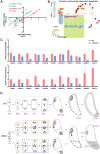OsRH52A, a DEAD-box protein, regulates functional megaspore specification and is required for embryo sac development in rice
- PMID: 38642102
- PMCID: PMC11350083
- DOI: 10.1093/jxb/erae180
OsRH52A, a DEAD-box protein, regulates functional megaspore specification and is required for embryo sac development in rice
Abstract
The development of the embryo sac is an important factor that affects seed setting in rice. Numerous genes associated with embryo sac (ES) development have been identified in plants; however, the function of the DEAD-box RNA helicase family genes is poorly known in rice. Here, we characterized a rice DEAD-box protein, RH52A, which is localized in the nucleus and cytoplasm and highly expressed in the floral organs. The knockout mutant rh52a displayed partial ES sterility, including degeneration of the ES (21%) and the presence of a double-female-gametophyte (DFG) structure (11.8%). The DFG developed from two functional megaspores near the chalazal end in one ovule, and 3.4% of DFGs were able to fertilize via the sac near the micropylar pole in rh52a. RH52A was found to interact with MFS1 and ZIP4, both of which play a role in homologous recombination in rice meiosis. RNA-sequencing identified 234 down-regulated differentially expressed genes associated with reproductive development, including two, MSP1 and HSA1b, required for female germline cell specification. Taken together, our study demonstrates that RH52A is essential for the development of the rice embryo sac and provides cytological details regarding the formation of DFGs.
Keywords: Oryza sativa; Cell specification; DEAD-box RNA helicase; chalazal functional megaspore; double-female-gametophyte; embryo sac; rice.
© The Author(s) 2024. Published by Oxford University Press on behalf of the Society for Experimental Biology.
Conflict of interest statement
The authors declare that they have no conflicts of interest in relation to this work.
Figures








Similar articles
-
Unlocking fertility in the female gametophyte: a DEAD-box RNA helicase is essential for embryo sac development and seed setting.J Exp Bot. 2024 Aug 28;75(16):4684-4688. doi: 10.1093/jxb/erae220. J Exp Bot. 2024. PMID: 39192694 Free PMC article.
-
Two highly similar DEAD box proteins, OsRH2 and OsRH34, homologous to eukaryotic initiation factor 4AIII, play roles of the exon junction complex in regulating growth and development in rice.BMC Plant Biol. 2016 Apr 12;16:84. doi: 10.1186/s12870-016-0769-5. BMC Plant Biol. 2016. PMID: 27071313 Free PMC article.
-
Auxin Import and Local Auxin Biosynthesis Are Required for Mitotic Divisions, Cell Expansion and Cell Specification during Female Gametophyte Development in Arabidopsis thaliana.PLoS One. 2015 May 13;10(5):e0126164. doi: 10.1371/journal.pone.0126164. eCollection 2015. PLoS One. 2015. PMID: 25970627 Free PMC article.
-
The long and winding road: transport pathways for amino acids in Arabidopsis seeds.Plant Reprod. 2018 Sep;31(3):253-261. doi: 10.1007/s00497-018-0334-5. Epub 2018 Mar 16. Plant Reprod. 2018. PMID: 29549431 Review.
-
Understanding the Functional Megaspore Development: Current Status/Progress, Perspectives.Plant Cell Environ. 2025 Jul;48(7):4921-4927. doi: 10.1111/pce.15493. Epub 2025 Mar 25. Plant Cell Environ. 2025. PMID: 40130504 Review.
Cited by
-
Unlocking fertility in the female gametophyte: a DEAD-box RNA helicase is essential for embryo sac development and seed setting.J Exp Bot. 2024 Aug 28;75(16):4684-4688. doi: 10.1093/jxb/erae220. J Exp Bot. 2024. PMID: 39192694 Free PMC article.
-
Identification of a Novel Rice Chromosomal Translocation Line that Could Cause the Heterozygote Semi-Sterility and be Overcome by Genomic Duplication.Rice (N Y). 2025 Aug 18;18(1):77. doi: 10.1186/s12284-025-00835-y. Rice (N Y). 2025. PMID: 40824450 Free PMC article.
References
-
- Ao C-Q. 2013. Developmental origins of the conjoined twin mature embryo sacs in Smilax davidiana, with special notes on the formation of their embryos and endosperms. American Journal of Botany 100, 2509–2515. - PubMed
-
- Awasthi A, Paul P, Kumar S, Verma SK, Prasad R, Dhaliwal HS.. 2012. Abnormal endosperm development causes female sterility in rice insertional mutant OsAPC6. Plant Science 183, 167–174. - PubMed
-
- Cao GQ, Gu HH, Jiang WJ, et al.. 2022. BrDHC1, a novel putative DEAD-box helicase gene, confers drought tolerance in transgenic Brassica rapa. Horticulturae 8, 707.
MeSH terms
Substances
Grants and funding
LinkOut - more resources
Full Text Sources

